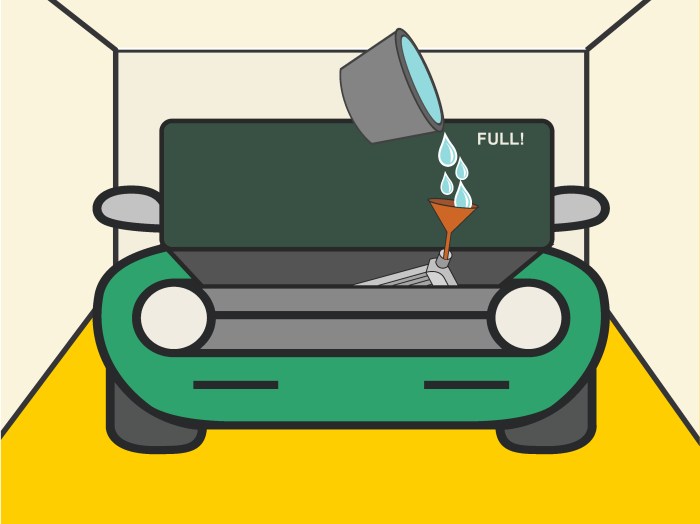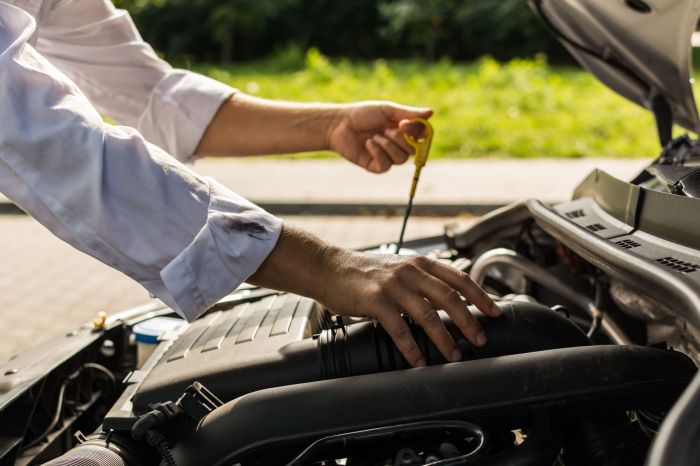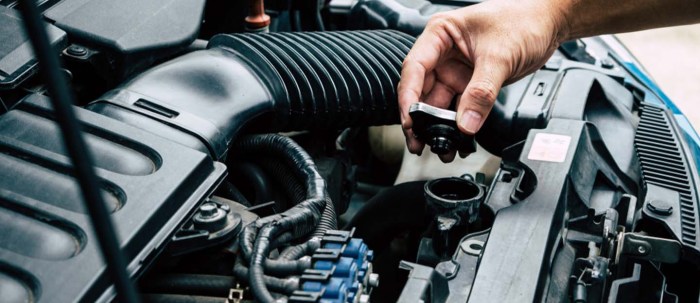How to flush a car radiator at home? It sounds kinda intimidating, right? But trust me, it’s way easier than you think and way cheaper than taking it to a mechanic. This guide will walk you through the whole process, from gathering supplies to topping off with fresh coolant. You’ll learn why regular radiator flushes are crucial for your car’s health and how to avoid costly repairs down the road.
Plus, you’ll get that satisfying feeling of DIY accomplishment.
We’ll cover everything from identifying the right tools and safely draining the old coolant to understanding different flushing methods and ensuring you properly bleed the air from your system. Think of it as a mini-automotive engineering project – you’ll be amazed at how much you can learn about your car’s cooling system. Get ready to dive in!
Introduction
Keeping your car’s cooling system in tip-top shape is crucial for preventing costly repairs and ensuring your engine’s longevity. Regular radiator flushes are a simple yet highly effective way to maintain this vital system, preventing overheating and extending the life of your engine. Neglecting this essential maintenance task can lead to significant problems down the road, potentially leaving you stranded and facing a hefty repair bill.Radiator flushing removes the buildup of rust, scale, and other contaminants that accumulate over time within the radiator and cooling system.
These deposits impede the efficient flow of coolant, reducing the system’s ability to dissipate heat. This can lead to engine overheating, a major problem that can cause serious damage, including warped cylinder heads, cracked engine blocks, and blown head gaskets – all of which are expensive to fix.
The Radiator’s Role in Engine Cooling
The radiator is a critical component of your car’s cooling system. Its primary function is to cool the engine coolant, which circulates through the engine block and cylinder head, absorbing heat generated during combustion. Hot coolant then flows into the radiator, where it passes through a network of thin tubes surrounded by fins. Air flowing over these fins dissipates the heat from the coolant, lowering its temperature before it’s circulated back through the engine.
A properly functioning radiator ensures that the engine operates within its optimal temperature range, preventing overheating and damage. A clogged radiator hinders this process, leading to increased engine temperatures and potential catastrophic failure.
Gathering Necessary Supplies and Tools

Getting your car’s radiator flushed is a pretty straightforward DIY project, but you’ll need the right stuff to do it safely and effectively. Failing to gather the correct supplies could lead to a messy situation or even damage to your vehicle. This section will Artikel everything you need to get started.
Essential Materials
Before you begin, gather all the necessary materials. Having everything on hand will make the process much smoother. This table lists the essential items, their purpose, and any special considerations.
| Item | Quantity | Purpose | Notes |
|---|---|---|---|
| Radiator Flush Solution | 1 container (follow product instructions for amount) | Chemically cleans the radiator and cooling system of rust, scale, and other deposits. | Choose a flush solution appropriate for your vehicle’s cooling system material (aluminum, brass, etc.). Read and follow all manufacturer instructions carefully. |
| Distilled Water | Several gallons | Rinses the cooling system after the flush solution and helps prevent corrosion. | Tap water contains minerals that can contribute to future buildup. Distilled water is crucial for a clean system. |
| New Coolant (Antifreeze) | As recommended by your vehicle’s manual | Provides anti-freeze protection and prevents corrosion. | Use the correct type and concentration of coolant specified for your vehicle to avoid damage. A 50/50 mix of coolant and distilled water is typical. |
| Drain Pan | 1 large capacity | Collects the old coolant and flush solution. | Ensure it’s large enough to hold several gallons of fluid. |
| Funnel | 1 | Helps to cleanly pour fluids into the radiator and overflow tank. | A wide-mouth funnel is ideal for easier pouring. |
| Gloves | 1 pair | Protects your hands from the chemicals in the flush solution and coolant. | Use heavy-duty gloves designed for chemical handling. |
| Safety Glasses | 1 pair | Protects your eyes from splashes of coolant or other fluids. | Essential for preventing eye injuries. |
Essential Tools
The tools required are relatively simple, but their correct use is vital. Improper use can lead to damage or injury. The following description details the function and importance of each tool.Imagine a visual representation here: A simple drawing showing a wrench (for the radiator drain plug), a screwdriver (potentially needed for access panels), a funnel, a drain pan, and a pair of pliers (potentially needed for stubborn hose clamps).The wrench is used to loosen and tighten the radiator drain plug.
A screwdriver might be needed to remove access panels to get to the drain plug or other components. The funnel prevents spills while refilling the system. The drain pan catches the old coolant. Pliers might be needed if you have trouble removing stubborn hose clamps. All these tools are essential for a safe and effective radiator flush.
So, you’re tackling a radiator flush at home? It’s way easier than figuring out the intricacies of AI-driven luxury car personalization 2025 , which, honestly, sounds pretty futuristic. Anyway, back to that radiator – remember to disconnect the hoses carefully before draining the coolant. Proper flushing ensures your engine stays cool and happy.
Safety Precautions
Before you even think about cracking open your car’s cooling system, remember safety first! Coolant is toxic and can cause serious harm if ingested or if it comes into contact with your skin.
Always allow the engine to cool completely before starting the flush. Hot coolant can cause severe burns.
Wear gloves and safety glasses throughout the entire process. Coolant is toxic and can irritate your skin and eyes.
Work in a well-ventilated area. The fumes from the flush solution and coolant can be harmful.
Dispose of the old coolant properly. Check with your local waste disposal authority for guidelines on proper disposal of automotive fluids. Don’t just pour it down the drain!
Draining the Radiator Fluid

Okay, so you’ve got your supplies, now it’s time to get your hands dirty (metaphorically, hopefully!). Draining the old coolant is a crucial step in flushing your radiator, ensuring all that nasty old gunk gets out of there. This process is pretty straightforward, but safety first, always.Before you start, remember that coolant is toxic. Wear gloves and eye protection.
Also, make sure your engine is completely cool – you don’t want to burn yourself. We’re talking completely cold, not just lukewarm. Give it a few hours after driving.
Radiator Drain Plug Location and Removal
The radiator drain plug is usually located at the bottom of the radiator, often near one of the lower radiator hoses. It’s typically a small, threaded plug, sometimes capped with a plastic cover. It might be brass, plastic, or even metal. Consult your car’s owner’s manual for the exact location; it’s different for every car model. Once you locate it, use the correct size wrench to carefully loosen the plug.
Don’t force it; if it’s stuck, try using some penetrating oil to help loosen it. Turn it counter-clockwise to unscrew it. Once it’s loose, you can usually unscrew it by hand.
Collecting the Used Coolant
Now for the important part: responsible disposal. Coolant is harmful to the environment and shouldn’t be dumped down the drain or on the ground. Before you start draining, position a large container (at least a gallon, preferably larger) underneath the drain plug. A drain pan specifically designed for automotive fluids works great, but a large bucket will also suffice.
Make sure the container is large enough to hold all the coolant that will come out. Once the drain plug is removed, the coolant will begin to flow. Let it drain completely, this may take several minutes. Once the flow stops, you can tighten the drain plug back into place. Remember to check for leaks after you’ve tightened it.
Now you have a container full of used coolant; take it to your local auto parts store or recycling center for proper disposal. They usually have a program for recycling used automotive fluids. Don’t just toss it in the trash!
Flushing the Radiator System
Now that the old coolant is drained, it’s time to actually flush the radiator and engine block. This step is crucial for removing any remaining rust, scale, or other contaminants that could hinder efficient cooling and potentially damage your engine. A thorough flush will leave your system clean and ready for fresh coolant.
There are several methods you can use to flush your car’s radiator, each with varying levels of effectiveness and effort involved. The best method depends on the condition of your cooling system and the tools you have available. Let’s explore a couple of common approaches.
Radiator Flushing Methods
Choosing the right flushing method depends on your comfort level and the severity of the buildup in your cooling system. A simple garden hose flush might suffice for a relatively clean system, while a chemical flush is better for systems with significant deposits. The key is to ensure thorough cleaning to prevent future problems.
- Garden Hose Flush: This is the simplest method. Connect a garden hose to the radiator drain valve (after reinstalling the drain plug, of course!), and run water through the system for several minutes. You’ll want to periodically check the water coming out of the drain valve – once it runs clear, you’re good to go. This method is best for systems that only require a light cleaning.
It’s quick and requires minimal tools, but it might not remove stubborn deposits.
- Flushing Solution Flush: For a more thorough cleaning, you can use a radiator flush solution. These solutions are commercially available at most auto parts stores. Follow the instructions on the product packaging carefully. Generally, you’ll add the solution to the radiator, run the engine for a specified time, then drain the solution and flush with clean water. This method is more effective at dissolving and removing rust and scale than a simple water flush, making it ideal for systems with significant buildup.
However, it does require purchasing an additional product and following more involved instructions.
Comparison of Flushing Techniques
The effectiveness of each method is directly related to the level of contamination in the cooling system. A garden hose flush is adequate for preventative maintenance or minor cleaning. However, if your coolant is heavily discolored or you suspect significant scale buildup, a chemical flush is necessary for optimal results. The chemical flush is more thorough but requires more time and the additional cost of the flushing solution.
Ultimately, the best approach depends on your system’s condition and your preference for a quick-and-easy or a more thorough cleaning process.
Ensuring Complete Coolant Removal
Regardless of the flushing method you choose, ensuring complete removal of old coolant and debris is vital. Simply draining the radiator isn’t enough, as old coolant and sediment can remain in the engine block and hoses. Multiple flushes with clean water are recommended to guarantee complete removal. You should continue flushing until the water exiting the drain valve runs clear and free of any discoloration or sediment.
This might require several cycles of adding water, running the engine briefly (with the heater on), and then draining again. For a chemical flush, follow the manufacturer’s instructions for rinsing the system completely. Remember to always consult your vehicle’s owner’s manual for specific recommendations and precautions.
Refilling the Radiator with New Coolant
After you’ve thoroughly flushed your radiator, it’s time to refill it with fresh coolant. This step is crucial for maintaining your engine’s optimal operating temperature and preventing overheating. Using the correct coolant type and mixture is essential for preventing corrosion and maximizing the lifespan of your cooling system components.Getting the right coolant mixture is key to protecting your engine.
The standard recommendation is a 50/50 mix of coolant (often called antifreeze) and distilled water. Using distilled water is important because it’s free of minerals that can contribute to scale buildup and corrosion inside your radiator and engine block. Tap water, on the other hand, contains minerals that can cause these problems. The coolant itself provides anti-corrosion properties and helps prevent freezing in colder climates.
The 50/50 ratio provides the best balance of these protective properties. Always check your vehicle’s owner’s manual for the specific coolant type and mixture recommended by the manufacturer; some vehicles may require specific types of coolant.
Coolant Type and Amount
Choosing the correct coolant is as important as the mixture ratio. Most modern vehicles use a type of coolant called 50/50 pre-mix, which already contains the correct proportion of coolant and distilled water. If you’re using a concentrate, carefully follow the instructions on the container to achieve the correct 50/50 mix. To determine the amount of coolant needed, consult your vehicle’s owner’s manual.
It will specify the radiator’s capacity and the total capacity of the entire cooling system (including the engine block). You’ll likely need to add coolant to both the radiator and the overflow reservoir. Remember, it’s better to slightly underfill than to overfill.
Bleeding the Air from the Cooling System
Air pockets trapped in the cooling system can prevent proper coolant circulation, leading to overheating. Therefore, bleeding the air is an essential part of the refilling process. The method for bleeding the air varies depending on the vehicle. Some vehicles have a specific bleed valve on the radiator or engine block. Others require you to run the engine for a period with the radiator cap removed, allowing air bubbles to escape.
Your vehicle’s owner’s manual will provide detailed instructions on how to properly bleed your specific vehicle’s cooling system. If you have a bleed valve, carefully open it while someone else slowly adds coolant to the radiator. Close the valve once a steady stream of coolant flows without any air bubbles. If your vehicle doesn’t have a bleed valve, start the engine and let it run for a few minutes, keeping an eye on the coolant level.
So, you’re thinking about flushing your car’s radiator? It’s a pretty straightforward DIY project, but before you get your hands dirty, maybe consider diversifying your investments. Check out this article on Luxury car investment opportunities 2025 – you might find a future classic that needs a radiator flush someday! Then, once you’ve got your financial future sorted (or at least thought about it), you can get back to that coolant flush.
Add more coolant as needed to maintain the proper level. Monitor the temperature gauge carefully; if it starts to rise, turn off the engine immediately. After the engine has cooled, check the coolant level again and top off if necessary. Remember to always allow the engine to cool completely before removing the radiator cap to prevent burns from hot coolant.
Post-Flush Checks and Maintenance
After you’ve successfully flushed your car’s radiator, it’s crucial to perform a few checks to ensure everything is working correctly and to prevent future problems. Neglecting this step could lead to overheating, further damage to your engine, or even a breakdown. This section Artikels the necessary post-flush inspections and a recommended maintenance schedule to keep your cooling system in top shape.Properly checking your system after a flush involves a visual inspection for leaks and a verification that the cooling system is functioning as intended.
Failure to do so could lead to costly repairs down the line, so it’s worth taking the time to do this correctly.
Leak Detection
A thorough visual inspection is the first step in checking for leaks. Carefully examine all hoses, clamps, and connections for any signs of coolant leakage. Look for damp spots, puddles, or trails of green or orange fluid (depending on your coolant type). Pay close attention to the radiator itself, checking for leaks around the seams, the drain plug, and the pressure cap.
If you find any leaks, tighten loose clamps or replace damaged hoses or components as needed. A small leak might be easily fixed with a clamp, but a larger leak usually necessitates hose replacement. For more serious leaks originating from the radiator itself, radiator repair or replacement may be necessary. Remember to always let the engine cool completely before performing any inspection or repair.
Coolant Level and System Pressure
Once you’ve visually inspected for leaks, check the coolant level in the radiator’s overflow reservoir. The level should be within the marked minimum and maximum lines. If it’s low, you may have a leak somewhere in the system, or air may have gotten trapped. To check for trapped air, carefully open the radiator cap (after allowing the engine to cool completely!), and add more coolant if necessary.
You can also check the system pressure using a pressure tester, which is readily available at most auto parts stores. This tool will allow you to determine if there are any leaks under pressure, which might not be visible during a visual inspection. A pressure test can help identify even small leaks that may not be immediately obvious.
Overheating and Temperature Monitoring
After the flush and refill, closely monitor your engine’s temperature gauge during operation. Consistent overheating after a flush could indicate a more serious problem, such as a faulty thermostat, a clogged water pump, or a failing radiator. If the gauge consistently shows high temperatures, immediately pull over and turn off the engine to prevent serious engine damage. It’s important to address any overheating issues promptly to avoid further problems.
For example, a consistently overheating engine can lead to warped cylinder heads, requiring costly repairs.
Radiator Maintenance Schedule, How to flush a car radiator at home
To maintain your cooling system’s health, adhere to a regular maintenance schedule. A good rule of thumb is to flush your radiator every two years or every 24,000 to 36,000 miles, depending on your vehicle’s usage and the type of coolant used. Additionally, regularly inspect hoses and clamps for wear and tear, replacing them as needed. Checking your coolant level regularly, ideally before each long trip, is also a good preventative measure.
This routine maintenance will help extend the life of your cooling system and prevent costly repairs in the long run. Remember to consult your vehicle’s owner’s manual for specific recommendations on coolant type and maintenance intervals.
Dealing with Specific Radiator Issues (Optional): How To Flush A Car Radiator At Home

So, you’ve flushed your radiator, but maybe things aren’t quite right. This section covers some common radiator problems and how to address them. Remember, tackling car repairs can be tricky, and sometimes professional help is the best option.
Common Radiator Problems and Solutions
This table summarizes common radiator issues, their causes, solutions, and preventative measures. Knowing these can save you headaches (and potentially a lot of money) down the line.
| Problem | Cause | Solution | Prevention |
|---|---|---|---|
| Clogged Radiator | Buildup of rust, scale, or other debris restricting coolant flow. This is often exacerbated by using hard water or neglecting regular coolant flushes. | A thorough radiator flush, potentially requiring specialized cleaning solutions or even professional cleaning equipment. In severe cases, radiator replacement may be necessary. | Regular coolant flushes (as Artikeld earlier), using distilled water for coolant mixing, and ensuring your coolant is the correct type for your vehicle. |
| Radiator Leaks | Corrosion, cracks, punctures, or damaged seals in the radiator itself, or leaks in the hoses connecting the radiator to the engine. | Minor leaks might be temporarily patched with a radiator stop leak product (use with caution and follow instructions carefully!), but often require radiator repair or replacement. Hose leaks are usually addressed by replacing the damaged hose. | Regular visual inspections of the radiator and hoses for signs of damage or leaks. Addressing small issues promptly before they worsen. |
| Damaged Radiator Hoses | Age, wear and tear, overheating, or physical damage (e.g., rubbing against other components). Hoses can become brittle, crack, or burst. | Replacing the damaged hose with a new one of the correct size and type. | Regular inspection of hoses for cracks, bulges, or other signs of deterioration. Replacing hoses before they fail. |
| Low Coolant Level | Leak in the radiator, hoses, water pump, or head gasket; or simply forgetting to top off the coolant. | Locate and repair the leak (if present), then refill the radiator with the correct coolant mixture. Regularly check and maintain the coolant level. | Regular coolant level checks, prompt repair of any leaks, and using a coolant recovery tank (if equipped). |
Situations Requiring Professional Help
Some radiator problems are best left to professionals. For instance, if you suspect a head gasket leak (often indicated by white smoke from the exhaust, milky oil, or overheating), this is a serious issue requiring specialized diagnostic tools and repair expertise. Similarly, if you’ve attempted a radiator repair and the leak persists or worsens, seeking professional help is recommended to prevent further damage to your engine.
Complex radiator repairs or replacements might also be better left to mechanics with the proper equipment and experience. Don’t hesitate to get professional assistance if you’re unsure about tackling a repair yourself.
Ultimate Conclusion
So, there you have it! Flushing your car’s radiator at home is totally doable, even for a complete novice. By following these steps and taking the necessary precautions, you can significantly extend the life of your cooling system and avoid expensive repairs. Remember, regular maintenance is key, and now you have the knowledge to handle this important task yourself.
Go forth and conquer that radiator!









